Although I am not Korean, I have a lot of memories of Korean food since my middle school days. There was something called the Korean Wave (Hallyu) that was rising since the late 90’s and was coming over to the States and other countries. What it was and still is, is the popularity of movies/dramas, food and music from South Korea.
As I was becoming a teenager, I was trying to figure myself out. What kind of music did I like? What foods do I like? What type of shows do I like? Since my parents could not afford cable, we had a regular television set. In one of those days, I was flipping around different channels that would only display to me shows in another language. As I was ready to turn off the TV, a group of femine but masculine men showed up on screen singing in a catchy tune and wearing elaborate outfits. I was curious what I was watching and continued to watch until the song ended and the group name appeared on the screen. I was amazed and wanted to know more. I began to research about this group and the type of genre that came up was “K-Pop” (Korean Pop). I showed one of my siblings and we began to watch together as we started learning the different groups there were at the time. We were hooked!
Going to Koreatown was the first time I tasted Korean food. My siblings and I went to a local mall we heard had posters and CD’s of Korean Pop artists. After shopping for some time, we were hungry and decided to get Korean food at the food court. I remember that was the first time I ate something different from what I was used to and it also opened the doors that lead me to trying different foods in the future.
I clearly remember ordering a Korean soup like I have seen in the dramas, to my surprise however, the soup came out cold. I thought there was a mistake and my mom also asked me to send it back since it was ice cold with ice cubes in it! That was for sure a culture shock I didn’t expect to experience. When I went to go return the dish, I reread the menu and it said “Cold Soup,” when I looked it up, I found it was supposed to be cold to cool you down during the hot summer days! After explaining to my mother, she was still confused and would look at my dish with curiosity when I began to eat it. I could not get the hang of the taste but after awhile, I was wanting more when I finished it!
After the years, the Hallyu Wave became even bigger. Conventions were being held and people were also holding group dances and recording them on youtube. I continued my journey in trying all different types of foods since I was living in a very diverse county.
Even after years later, me and my siblings go to Koreatown to make memories and eat the food there. A few weeks ago, I recommended we go to a popular restaurant that only serves Tteok-bokki (Spicy Rice Cakes) and even makes it as a challenge for people who want to try the super hot version of it. The place is called Yup Dduk La and even though we chose the extra mild (least spicy) on the menu, it was still too spicy for me.
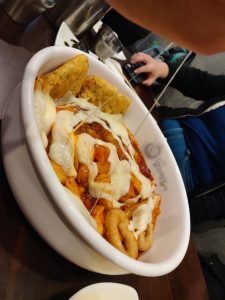
Last week, my siblings and I decided to go to H-mart in Torrance, a popular Korean grocery store. There we bought all the ingredients needed to make the Tteok-bokki the way we wanted.
Ingredients:
- Rice Cakes (Bags depending on how many people you will cook for)
- Pickled Radish (Optional)
- Kimchi (Optional)
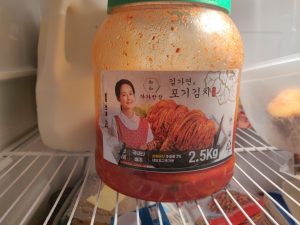
- Gochujang (Spicy or Sweet)
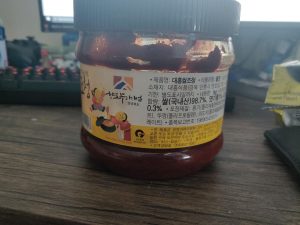
- Ramen Noodles
- Mozzarella Cheese (Recommended)
- Corn (Optional)
- Seaweed (Optional)

- Korean Sausages (Optional)
There are many ways to make Tteok-bokki. Some people like it spicy than sweet, I am the opposite. Some people will add hard boiled eggs, green onions, fish cakes (most common), sesame seeds, etc,. Since me and my siblings wanted to make it the way we wanted it to, we created the perfect recipe for us.
Some recipes will be a little difficult to find if you are not used to an asian market. However, most markets now I have english on top of the aisle boards to make it easier to spot some ingredients. The rice cakes we found were in the frozen part of the fridge. I usually find them in two different locations in the Korean markets. The Kimchi, Korean Sausages and the Pickled Radish will also be found in the refrigerator aisle. There are different types of Pickled Radish so one can choose which one they prefer. Of course the Ramen Noodles will be in the noodle aisle and the Gochujang will mostly be in the sauce aisle. There are different spicy levels from mild to super hot. I always like to choose the mild so the spiciness is not overpowering and I can actually taste the dish.
Step 1: In a pot, add water to a boil. Afterwards, put in the rice cakes until they have become chewy. Drain and put aside.
Step 2: In another pot, cook the ramen noodles with water that has begun to boil (We added 5 packets). My sister chose a popular ramen in South Korea called Buldak-bokkeum-myeon. There are many popular youtube videos doing the challenge of these noodles since they are also known to be nuclear hot. Her and I agreed to put some of the nuclear sauce in but also add more of the sweet Gochujang sauce my mother in law made for me so everyone could eat it. Add packets of flavoring to the pot plus a little bit of the nuclear sauce to add heat. After it is done, set aside.
Note: Since rice cakes take longer to cook, we suggest doing that first. Ramen noodles are quick to become soggy if cooked for too long so one should be mindful of that.
Step 3: Get another pot and combine the rice cakes and the ramen noodles in it. Start adding the Gochujang sauce and taste for your liking. We added frozen corn and blocks of cheese. Since I only had one block of Mozzarella cheese, we decided to add the other cheeses I had in my fridge as well. It was a mix of Colby and Monterey Jack cheese that added another great flavor to it! Add as much cheese as you want.

Step 4: Mix in any other add ons you want to your dish and turn on the medium heat. This is when I add the seaweed.
Note: Seaweed adds an umami flavor to the dish and I recommend it if one is not fond of fish cakes.
Step 5: In a separate pan, I decided to cook the sausages to make them a little bit more flavorful. They had already been cooked but wanted more of the meaty flavor to come out. After a few minutes, I then added the sausages into the big pot of rice cakes and continued to mix the pot until the sausages were well placed.
Note: If the rice cake seems too dry, I recommend using the soup that was left over when cooking the noodles. A little bit of moisture will make the dish easier to mix.
Step 6: When it is done, put the pot in the middle of a table or where you will be eating with family or friends. This can also be eaten by yourself in a small bowl. My sister is a huge fan of pickled korean radish so we put those as the sides, soy sauce, and kimchi. Enjoy!
My sister purchased four big bags of rice cakes. Since we are a family of seven, we had plenty to call over a friend and even have left over for days!
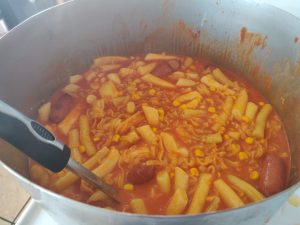
For me, this dish symbolizes a few things that I have associated it with. It reminds me of my second year anniversary with my husband at the cafe we had our first date in. It reminds me of the wonderful memories going to Koreatown with my siblings and trying out different foods we would discover.
In Roy Choi’s book LA Son, he shows us his LA in where he grew up in. After reading the book, I have discovered my Los Angeles and still doing so to this day. Although there are a lot of bad things about the city I live in, I can’t find another place like it. I really do love the diversity that this city has. I am able to travel the world without leaving the state. I am able to find people like me but also other people that are not. I am able to experience other perspectives that I would not be able to if I lived somewhere else.
A recipe that made my heart happy was Choi’s recipe on Korean Pupusas. Pupusas is the national dish of my parents home country, El Salvador. Just like Choi created the Korean taco, he also acknowledged another latino country and created the Korean Pupusa. In my opinion, making pupusas is a lot of work, however, I would really love to make this dish at least once in my life or even taste it. For me, this recipe represents my husband and I. As an interacial couple, I do not want to lose my culture while also not losing his culture when I cook. Some days I will make Latino food, other days I will make Korean food. I have yet to create one dish that represents both my culture and his. What I felt like was impossible, he was able to do it. It is like getting the best of both worlds. I have told my husband that it would be cool to open a Korean-Salvadoran fusion restaurant in Koreatown some day. For now, it is only a fleeting thought. However, Choi showed me that it is possible.
If there are any restaurants you are curious in checking out, I will recommend some places. Yellow House is where I had my first date with the love of my life. They serve European/Korean/Japanese food in a delicious twist. White and Brown is my favorite Boba tea cafe where they serve their teas with cheese foam to give a sweet and salty taste. Another favorite of mine is Myungrang hot dogs, a popular corn dog street food that is on the rise in Asia. They put sugar on the corndog plus potatoes if you ask for it. My favorite is ordering the squid ink corndog that comes with sausage and mozzarella cheese. They also have a rice drink that you must try! It is like the horchata version drink of some Latino countries. Koreatown has endless possibilities of delicious foods. I am always discovering a new place or trying a new dish just by walking by. Everytime I have to visit my in-laws, I always make an excuse to try out the different restaurants in that area.
I know that over the years, Koreatown will be changing. Groups of people will come and go. My husband tells me all the places he used to go to as a child are now replaced with the stores and restaurants that have taken over. It is a little sad, but I think that is a bittersweet feeling that Los Angeles has over me.
Going back to Tteok-bokki, my favorite so far is in Yellow House and my newly homemade recipe. I am excited to share this new dish I learned and teach it to my children some day in the future. To clarify, Tteok-bokki is a wonderful comfort food but a really high calorie meal since you can eat a lot of rice cakes in a short amount of time. It should be eaten once in a while.
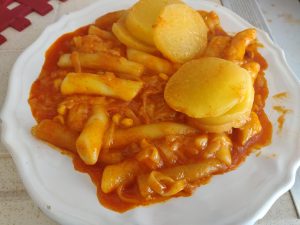
References:
- Korean Wave (Hallyu) – Rise of Korea’s Cultural Economy & Pop Culture. (2018, August 9). https://martinroll.com/resources/articles/asia/korean-wave-hallyu-the-rise-of-koreas-cultural-economy-pop-culture/
- Tteokbokki (Spicy Stir-fried Rice Cakes). (2019, October 3). https://www.koreanbapsang.com/tteokbokki-spicy-stir-fried-rice-cakes/
- Yup Dduk La – Wilshire Center – Los Angeles, CA. (2020, March 6). Retrieved from https://www.yelp.com/biz/yup-dduk-la-los-angeles
- Hot Chicken Flavor Ramen. (2019, December 30). https://en.wikipedia.org/wiki/Hot_Chicken_Flavor_Ramen
- Choi, R., Nguyen, T., & Phan, N. (2013). L.A. son my life, my city, my food. New York, NY: Ecco.
- [Stephanie Soo]. (2019, January 06). ALL 6 NUCLEAR NOODLE CHALLENGE MUKBANG | (Cheese + 2x NUCLEAR + Black Bean + More) Eating Show [Video File]. https://www.youtube.com/watch?v=Jyqvb8jtwbI

Pingback: Cookbook Index | IDS 336: American Appetites